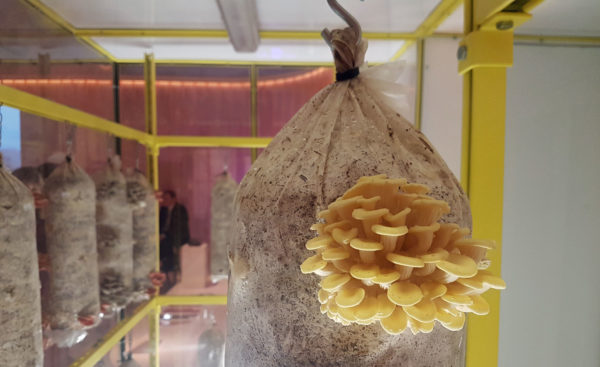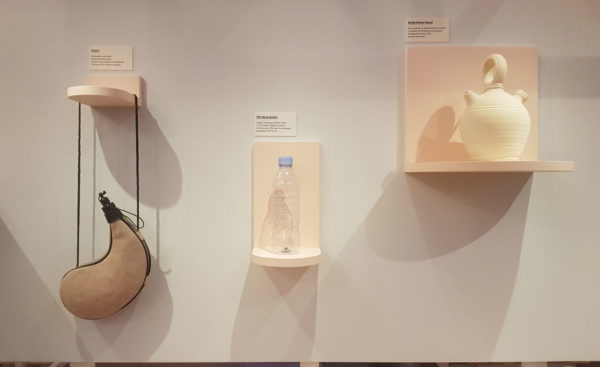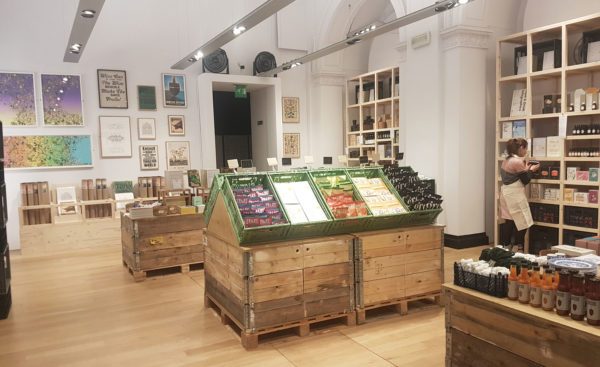Of all the great achievements of the 20th century, food has to be one of the greatest — not just the abundance of it, but how prices today are a fraction of what they used to cost.
But at what cost to the environment?
This is what the V&A looks at in its slightly hand-wringing exhibition about the food industry. Fortunately, rather than preach about things, they simply display and let you make up your own mind.
Two of the greatest concerns that people express are looked at by the exhibition – waste and the environmental impact of mass food production – not just climate change, but biological change.
It turns out that most chickens eaten today can trace their lineage to the “chicken of tomorrow” from 1948 which had been bred to have smaller bones and more meat. The California Fryer Cross — it was sold as good for, well, frying.
As many of us know, the lack of diversity in a crop, or animal, leads to higher risk that a single disease can now wipe out huge numbers of what farmers are trying to grow. So there’s an attempt to bread more diversity back into animals and plants. A large section looks at the chicken and attempts to cross breed them to be more diverse while still commercially viable.
Whether people really will go into the shops and buy the “odd” looking foods is a controversial issue, with the ugly vegetables brigade trading more on a desire to be seen to do good than actually having any real impact on food waste.
One big issue overlooked by the exhibition are food myths — and the myth of ugly fruit being thrown away continues to irk each time it appears. Where do you think the fruit juices and apple pies get their ingredients from? All the fruit that’s not sold in supermarkets. Mr Kipling makes exceedingly good cakes from ugly fruit.
Paradoxically, it’s the industrialisation of food production that has done so much to reduce waste, but that commercial aspect sits ill at ease with a society hankering for a return to more authentic foods.
Coffee, the modern staple is notorious for its wasteful production through, and a series of plastic sausages hanging in a cage filled with coffee waste are now being used to grow mushrooms. The difficulty is how to turn that into a commercial product that is both soaking up waste while also being affordable.
This is the great unspoken issue with food production.
One the one hand people want a better environment, but on the other, the rise of discount supermarkets shows that lower prices are a bigger attraction to the majority. Would people used to spending an average of 15% of their income on food and drink be willing to see that rise to where it was 50 years ago — when eating swallowed up a third of the average wage packet?
A lot of the exhibition then looks at the future of food production — how more science not less could help return society to a more agreeable balance with nature.
Sadly, they don’t talk about the one big cause of food waste, which is the cost of transporting it from farm to table. Not the food miles that we talk of in the food rich countries, but the bad roads, bribery and cost of moving foods in developing nations. So much food is wasted in developing countries, the very places where more food is desperately needed.
But we are wasteful as well — one set of displays very cleverly shows three ways of carrying water, and the time it takes for the container to degrade if thrown away.
The plastic bottle’s impact is frankly nothing less than offensive.
The exhibition is thought provoking without being overly preachy, and that makes it a good exhibition. I would have liked some “myth busting” to have been included, which is a sad oversight, but we don’t like our prejudices to be challenged, and to do so can put people off visiting.
Back to the chickens though — as probably the most profound selection on display are the chicken bones. The difference between intensively reared and natural bird bones is palpably clear to see.
You have to wonder what we are doing to our own health if that’s what we’re eating.
The exhibition, FOOD: Bigger than the Plate is open at the V&A Museum until 20th October. Entry is £17.
The shop is quite good for once, and free to visit.













How refreshing to read the museum “simply display[s] and let[s] you make up your own mind.”
Refreshing? Blimey that’s how it’s been since time immemorial in your run of the mill civilised society.
We’re in danger of losing that logic to the detriment of all of us ~ even the no-platformers et al themselves.
We should be paying a price for food more commensurate with its value but how to make it fair to all of us and the chicken too for that matter? Ditto the planet.
As a step towards that, the novelty of seasonal availability could be reintroduced. I can hear the squeals already. Then a way to inhibit non-local produce wd follow on naturally. Thirdly; we took the mick out of real or trumped-up EEC regs on the geometry of sausages a while back. Yet nowadays supermarkets say that they can’t easily sell wonky veg. If there were no option but to buy what was in front of you, the shopper wd adjust.
Three things that aren’t revolutionary as we’ve lived with them for far longer than we have their modern replacements.
Guess what? There’d be a return of a thing called taste. Remember when a chicken tasted like a chicken, a lamb a lamb, a strawberry a fleeting explosion of joy in the summer sunshine. Not some chewy pap bought as a treat in winter and regretted that you didn’t wait six months for the real thing?